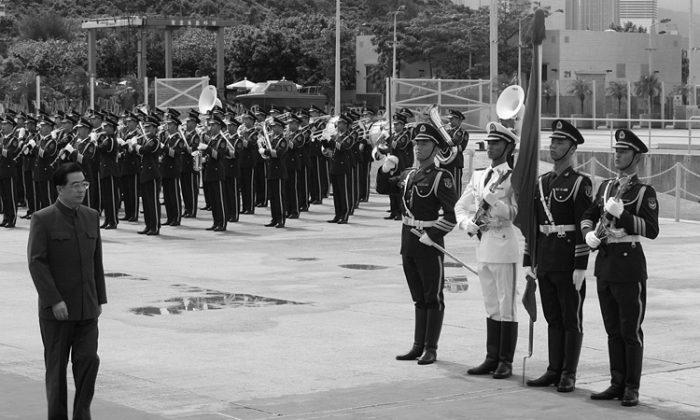[xtypo_dropcap]Y[/xtypo_dropcap]uan Shulin is a law-abiding citizen and resident of Zhengzhou, a city in east-central China’s Henan Province. Recently, whenever he used his second-generation ID card, police came to investigate him.
He was listed in the state’s public-security network as a “high-risk petitioner” even though he had never petitioned in his life. The Chinese regime considers petitioners to be a high risk to maintaining stability.
The national identification-card system for citizens of China was implemented in 1984. ID cards currently in use are known as second-generation ID cards.
Yuan made a business trip to Nanjing City in early September, and while checking into a hotel, he was told that there was an issue with his ID. Several days later, he took his child to a bath center. Police immediately appeared at the scene and told him that his ID background check indicated he had a bad record, according to a report by Henan Business Daily.
Since Yuan knew the police were monitoring him, he didn’t dare to use his ID or transact business outside of his hometown. He did not chance going to an Internet cafe or bath center again, much less staying in a hotel or making withdrawals through a bank teller.
When he inquired at a police station, he was told that his ID record had a bad history. He contested it, but no one would listen to him. He then related his experience to a Henan Business Daily reporter, offering to stage a scene for the benefit of the reporter.
When he tried use his ID to book a room at a hotel, within 10 minutes, two police officers came to the hotel and took him away. The police told the reporter that the public security network had disclosed that Yuan was listed as a high-risk petitioner.
As soon as he uses his ID for registration purposes, a police station in the immediate area is notified.
After the media exposure, the Guancheng Public Security Bureau, which oversees Yuan’s residential area, finally admitted that the Hanghai Road Police Station had made a mistake in data entry and corrected Yuan’s ID record.
‘Maintaining Stability’
Radio Free Asia (RFA) recently reported that a netizen disclosed a stability- maintenance document obtained from the Chunxiao Township website on Aug. 30. The township is in the Beilun District of Ningbo City, in southeast China’s Zhejiang Province. The document reveals that during the World Expo in Shanghai, the Chunxiao Township authorities set up a system to classify and control citizens in order to prevent them from going to Shanghai to engage in human rights activities.
The document shows that there are three levels of security monitoring and control: People classified at level A are key targets to be monitored. Those classified at level B need to be met each morning and evening to track their whereabouts. Those classified at level C are contacted by Comprehensive Management Offices, Police Stations, or Judicial Administrative Stations on a periodic basis.
The document was removed from the Chunxio Township government’s website not long after the Internet disclosure.
Continued on the next page...
Renowned blogger Guo Weidong from Zhejiang Province had his second-generation ID card checked at a train station on Aug. 28. He inadvertently found out that he is classified at the high-risk level of the regime’s system for maintaining stability.
Guo told RFA, “I swiped my ID card that afternoon and saw the stability-maintenance mark displayed at the bottom of the screen. … There was a green line for stability-maintenance status at the bottom with level three written on it. I was surprised, as I did not know that there were different classifications.”
Surveillance and Persecution
Former Chinese judge Grace Li told The Epoch Times that from 2008 to 2009, China replaced old ID cards with second-generation ID cards nationwide. Besides name, birthday, and ID number, the new card also has an embedded chip capable of storing additional information. The chip can be used to retrieve special information about the cardholder and can locate the cardholder.
Ms. Wang used to practice Falun Gong. In August 2009, she took a train to send her son off to college. When she transferred between trains in Beijing, through her ID card, police accessed her background information from the public-security network system. Although she no longer practiced Falun Gong, she was still forced to return to her hometown.
The Minghui.org (Clearwisdom.net) website, founded by Falun Gong practitioners, reported that many Falun Gong practitioners in China, who were blacklisted for practicing Falun Gong, were seized when providing their ID to board a plane or check into a hotel since a notice would immediately be sent to the respective police station.
Hotels in Beijing and other large cities are closely monitored. A Falun Gong practitioner can be arrested for using his or her ID card, subjected to imprisonment or other forms of persecution, and may be killed in the process.
A Minghui article disclosed that information on second-generation ID cards can be read by a detector within a short range. Many public locations, such as train stations, community entrances, and bus stations have plainclothes police officers carrying detectors that can read the second-generation ID cards of people passing by.
China’s Costly Security System
RFA reported that the Chinese regime began to implement strict supervision of hotels in Tibet in May. A Tibetan hotel manager told RFA that they were forced to install the second-generation ID card registration and monitoring system and required to hire security personnel trained by authorized organizations.
“We have completed the installation,” the manager said. “We had to do it. Lhasa Public Security Bureau issues permits for hotel and lodges. If you do not install it, you cannot get the permit.”
RFA also reported that at the end of June, Urumqi began to adopt new scanning technology to check train passengers’ ID cards. A resident told RFA, “The Urumqi West Train Station has a very tight security-check system when people buy tickets and enter the waiting room. You put your ID card near the machine, and it will read it.” Urumqi is home to many ethnic minority Uyghur Muslims.
Chinese media reported that beginning July 1, Internet cafes in Guangzhou City were required to scan customers’ second-generation ID cards. Over 1,500 Internet cafes in Wuhan City began adopting a second-generation ID card-recognition system as of June 16.
According to statistics released by the National People’s Congress in March, China’s internal security maintenance cost in 2009 had reached 514 billion yuan (US$76.66 billion), close to the amount of military spending, with an increase of 47.5 percent.
Lu Hailing, a Sina blogger, wrote on her blog that in 2009, China’s average daily spending on stability maintenance was US$206.5 million, close to the United States’ average day’s spending of $275 million during the Iraq war.




Friends Read Free